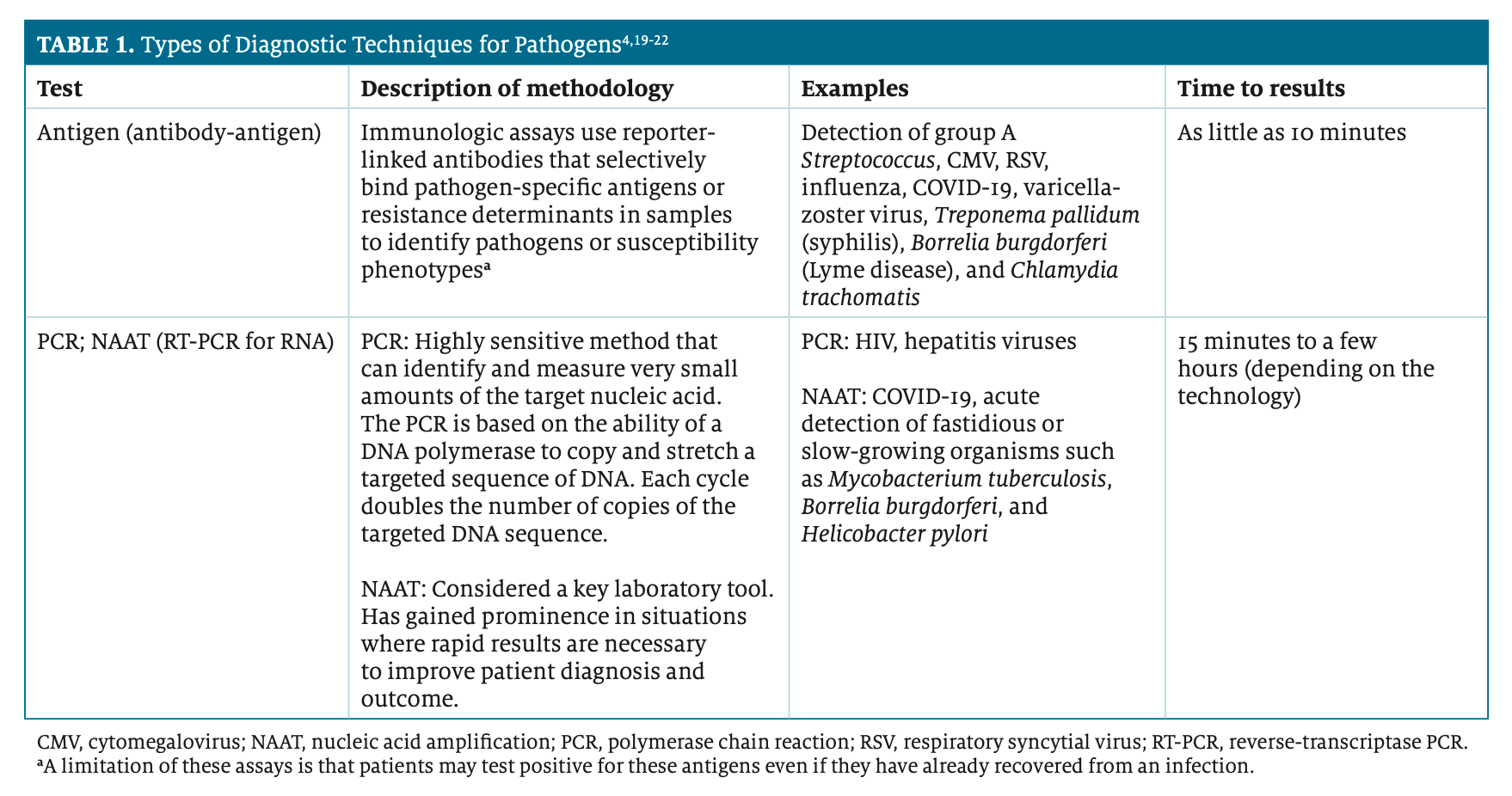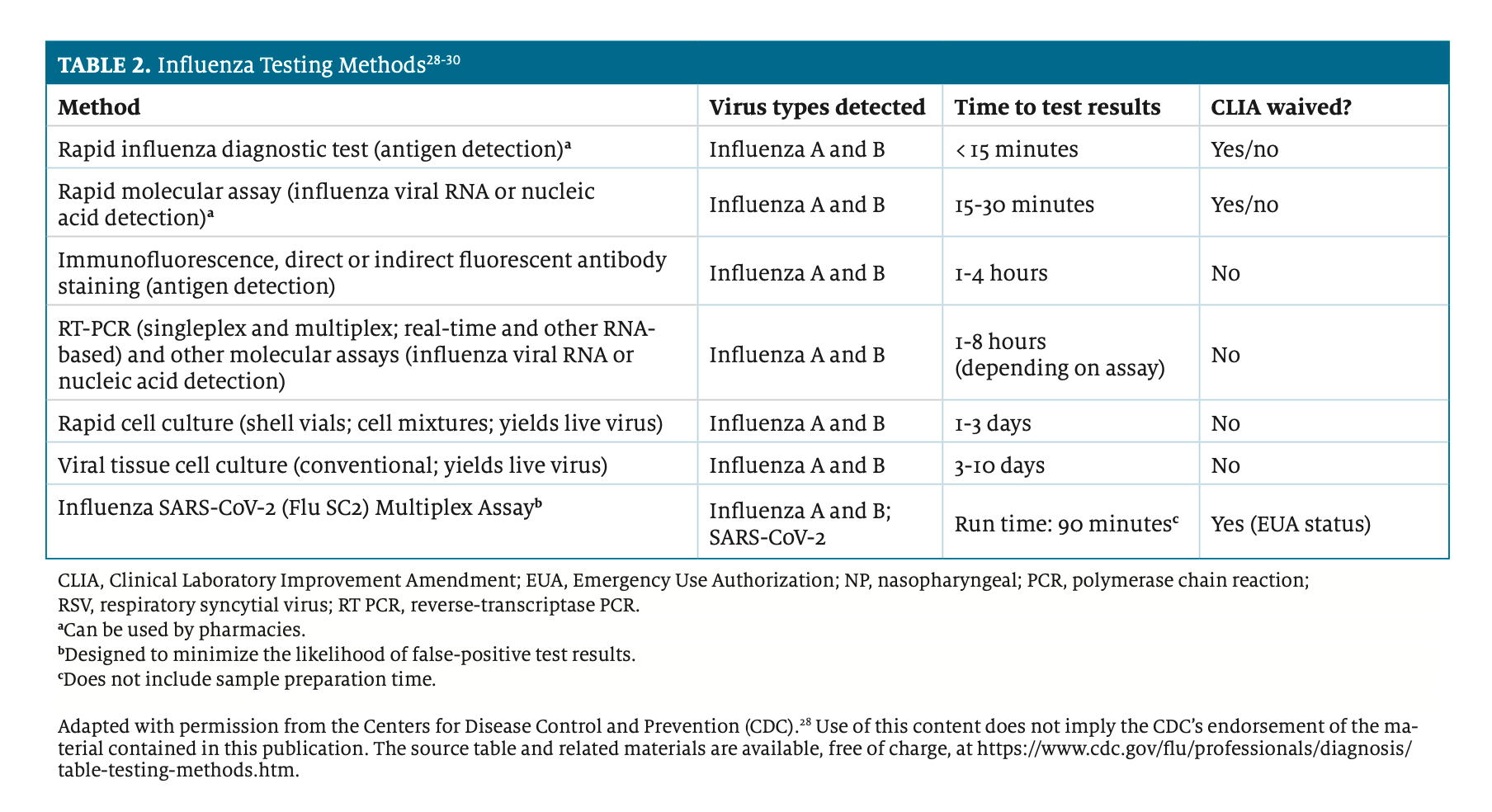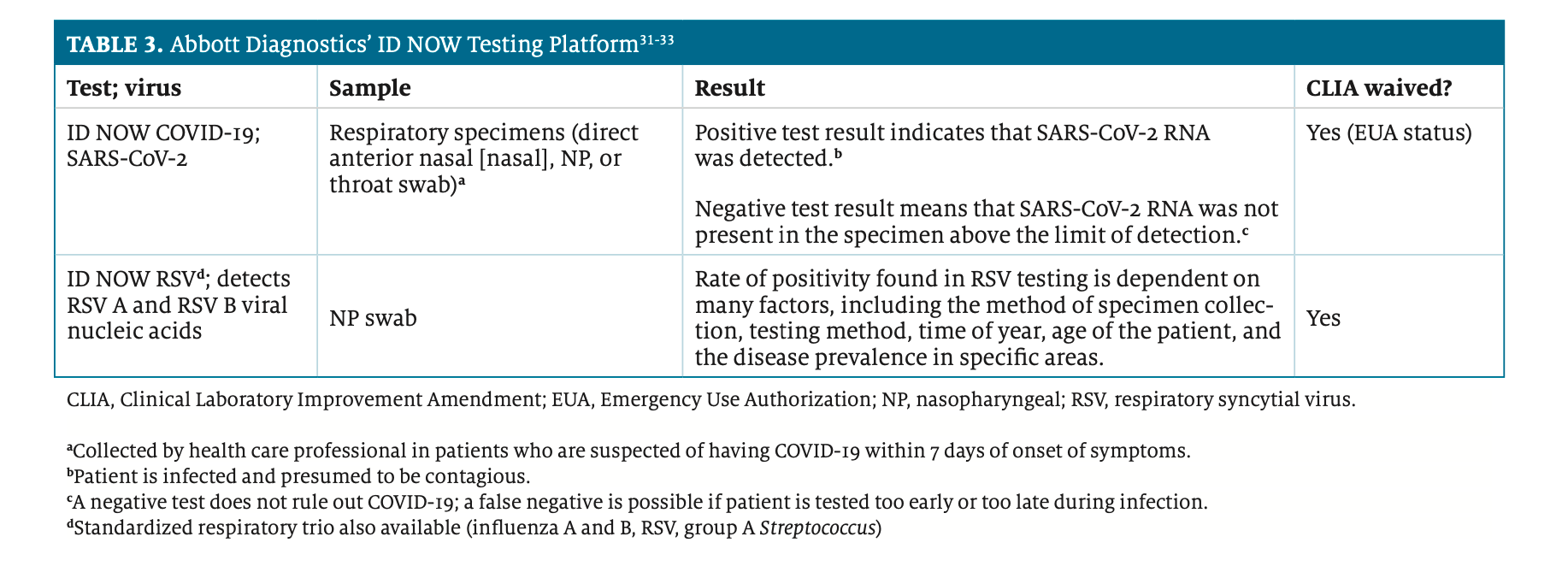Publication
Article
Supplements
Examining the Public Health Impact of Pharmacies as Additional Sites for Rapid Diagnostic Testing
Pharmacies and pharmacists are increasingly utilized for point-of-care (POC) services, including testing for infections that can be diagnosed via rapid testing.
Pharmacies and pharmacists are increasingly utilized for point-of-care (POC) services, including testing for infections that can be diagnosed via rapid testing, such as influenza, repiratory syncytial virus (RSV), COVID-19, and groups A Streptococcus (group A strep). Our health care system is evolving with greater demand for an expanded access model that includes utilizing the most accessible health care professionals: pharmacists.1
Rapid Diagnostic Testing for Respiratory Illness
The use of POC rapid diagnostic testing (RDT) is not new2; however, the global COVID-19 pandemic exacerbated the need for additional testing sites, such as phar- macies, for patients to access these types of tests.3 RDT can quickly identify or rule out a specific pathogen; the results can guide antimicrobial therapy (if appropriate), and aid in decisions regarding infection control measures, such as the need for isolation.4,5 Because rapid diagnostics can markedly reduce the time to pathogen identification and determination of antimicrobial susceptibility (when indicated), they offer providers the ability to optimize pharma- cotherapy.4 RDT for influenza became available in the 1990s and gained widespread use due to its ease of use, appropriateness for POC testing, and capability to provide quick results to best utilize therapeutics within 48 hours of symptom onset.2 Now, over-the-counter rapid diagnostic tests for COVID-19 have become widely available and are increasingly being used by the public for quick, at-home testing.6,7
Influenza viruses, RSV, group A strep, and SARS-CoV-2 all are common respiratory tract pathogens that cause a variety of signs and symptoms. The illnesses they cause are often spread through respiratory droplets released during talking, sneezing, or coughing by the infected individual.8-11 COVID-19, which is caused by the SARS-CoV-2 virus, and the flu share common symptoms including fever, chills, cough, runny nose, sore throat, or difficulty breathing. Symptoms may vary, and depending on the causative organism, there may be either a rapid or slow onset of symptoms or differences in duration of illness. SARS-CoV-2 infection can also result in specific symptoms such as loss of taste and smell, which are unique and differentiate COVID-19 from other infections.12 Surface transmission can also occur when a person touches an object that has droplets on it and then touches their mouth, nose, or eyes.
The influenza virus infects the nose, throat, and sometimes lungs.9 The most frequent symptoms are fever, chills, cough, sore throat, runny or stuffy nose, muscle or body aches, headache, and fatigue.
RSV affects the breathing passages (ie, nose and throat) and lungs. It is associated with cold-like symptoms, notably runny nose, decreased appetite, coughing, sneezing, fever, and wheezing. Infants, young children, and older adults are particularly susceptible to developing severe RSV infections, such as pneumonia and bronchiolitis (inflammation of the small airways in the lungs).10
Group A strep bacteria live in the nose and throats of infected individuals. The most common symptoms include sore throat, pain with swallowing, fever, red and swollen tonsils, and swollen lymph nodes.11
COVID-19 can be transmitted from respiratory droplets in the nose or throat of infected individuals; these droplets can linger in the air.8 Unlike the common cold, which is associated with symptoms that primarily affect the respiratory system and lungs, COVID-19 can also affect other body systems and produce a wide range of symptoms, with illness ranging from mild to severe.13 Symptoms may include fever, chills, cough, shortness of breath or difficulty breathing, fatigue, muscle or body aches, headache, new loss of taste or smell, sore throat, congestion and runny nose, nausea, vomiting, and diarrhea.14
Understanding if the infection is caused by a virus or a bacterium is extremely important, especially due to the rise in multidrug-resistant organisms from inappropriate antibiotic usage.4 For example, many pathogens are associated with pharyngitis; however, group A strep bacteria are the only ones that should be treated with an antibiotic.15 Contrast this with influenza, RSV, and COVID-19, which are all caused by viruses and have some similar symptoms but are managed very differently.16-18 The timing of the identification of these organisms also will determine if treatment is indicated. For influenza, antiviral treatment is most effective and ideally administered within 48 hours of onset of illness, although it can still be beneficial if given later.16 With COVID-19 infection, oral antivirals can be administered up to 5 days following symptom onset.18 Currently no specific therapy exists for RSV; however, early identification can ensure that supportive care can be administered quickly.17
Testing Modalities
It can be helpful to explain to patients the differences among common testing modalities so they understand why some tests are available in a pharmacy setting and others are not. Common testing methodologies are described in Table 1.4,19-22

Because RDT often necessitates the evaluation of a clinical specimen such as blood, stool, or bodily fluids, Clinical Laboratory Improvement Amendment (CLIA)-waived testing requirements must be met for testing to be performed in a pharmacy.4,19,23 Samples are used qualitatively or quantitatively to produce results within 15 minutes to a few hours, depending on the testing modality.4
During the COVID-19 pandemic, the HHS secretary declared a public health emergency and indicated the need to fast-track in vitro diagnostic tests to identify COVID-19 infection.24 Thus, the FDA made some tests available through its Emergency Use Authorization (EUA).25 The FDA may issue EUA status to a product when specific criteria are met. This includes times when there are no adequate, approved, or available alternatives, and the overall scientific evidence suggests that the product may be effective in preventing, diagnosing, or treating a specific condition.26 Diagnostic tests for COVID-19 given EUA have not undergone the same type of review as an FDA-approved or -cleared test.27 The use of these products is in effect only during the emergency declaration and will be terminated after it expires if full FDA clearance or approval is not obtained.

There are several types of testing methods to diagnose and, in some cases, rule out infection with the influenza virus, SARS-CoV-2, and RSV. Table 228-30 and Table 331-33 provide more detailed information about these tests.

An abundance of innovation arose out of necessity to accurately diagnose COVID-19. The use of unique tests, such as the CLIA-waived POC tests from Abbott (ID NOW), has been a game changer for many practices. These products can detect SARS-CoV-2, the influenza virus, and RSV. Details regarding the ID NOW testing platform are provided in Table 3.31-33
Quality control (QC) is extremely important when conducting POC testing.34 Proper procedures must be followed to ensure the accuracy of results. Multiple steps must be considered, including how the sample is collected, stored, and handled post collection. Proper handling of samples includes aseptic techniques and the use of personal protective equipment, including clean gloves.35 Further, it is important to control the temperature of the laboratory samples and testing solutions. Most are required to be at room temperature before testing can be performed.30,32,36 Positive and negative controls should be tested using the QC test instructions included with the platform.36 QC results are generated as pass or fail. If the QC test fails, no further testing should be performed using that device.
Conclusions
CLIA-waived POC testing is a value-added service that can expand the scope of practice for many community pharmacies. This needed and valuable service to the community can directly impact public health by decreasing the incidence of communicable disease. The early identification, treatment, and management of infectious diseases such as influenza, RSV, group A strep, and COVID-19 can have major societal implications, such as reducing lost work days and productivity. Results from RDT facilitate proper therapeutic management and reduce inappropriate antibiotic utilization. The COVID-19 pandemic has shown us that these types of services can be easily incorporated into the pharmacy setting with some purposeful planning and training. In addition, among the newest platforms are those that have made testing even easier by using a single device to detect multiple organisms via molecular testing. If these types of services were offered in even half of all pharmacy settings, the impact would be tremendous. Increased health and wellness of our communities is possible through these innovative solutions.
About The Author
Christina M. Madison, PharmD, FCCP, AAHIVP, is the founder and CEO of The Public Health Pharmacist, PLLC, in Las Vegas, Nevada.
References
1. Gasdek Manolakis P, Skelton JB. Pharmacists’ contributions to primary care in the United States collaborating to address unmet patient care needs: the emerging role for pharmacists to address the shortage of primary care providers. Am J Pharm Educ. 2010;74(10):S7. doi:10.5688/aj7410s7
2. Green DA, StGeorge K. Rapid antigen tests for influenza: rationale and significance of the FDA reclassification. J Clin Microbiol. 2018;56(10):e00711-e00718. doi:10.1128/JCM.00711-18
3. Coronavirus (COVID-19) update: FDA issued Emergency Use Authorization for point of care antigen test. News release. FDA; July 6, 2020. Accessed June 20, 2022. https://www.fda.gov/news-events/press-an-nouncements/coronavirus-covid-19-update-fda-issued-emergency-use- authorization-point-care-antigen-test
4. Werth BJ, Barber KE, Smith JR, Rybak MJ. Laboratory Tests to Direct Antimicrobial Pharmacotherapy. In: DiPiro JT, Yee GC, Posey L, Haines ST, Nolin TD, Ellingrod V. eds. Pharmacotherapy: A Pathophysiologic Approach, 11e. McGraw Hill; 2020. Accessed June 29, 2022. https://accesspharmacy. mhmedical.com/content.aspx?bookid=2577§ionid=219306547
5. Guidance for antigen testing for SARS-CoV-2 for healthcare providers testing individuals in the community. Centers for Disease Control and Prevention. Updated April 4, 2022. Accessed June 20, 2022. https://www.cdc. gov/coronavirus/2019-ncov/lab/resources/antigen-tests-guidelines.html
6. Rader B, Gertz A, Iuliano AD, et al. Use of at-home COVID-19 tests – United States, August 23, 2021-March 12, 2022. MMWR Morb Mortal Wkly Rep. 2022;71(13):489-494. doi:10.15585/mmwr.mm7113e1
7. Rubin R. COVID-19 testing moves out of the clinic and into the home. JAMA. 2021;326(14):1362-1364. doi:10.1001/jama.2021.15679
8. How COVID-19 spreads. Centers for Disease Control and Prevention. Updated July 14, 2021. Accessed June 20, 2022. https://www.cdc.gov/ coronavirus/2019-ncov/prevent-getting-sick/how-covid-spreads.html
9. Key facts about influenza (flu). Centers for Disease Control and Prevention. Reviewed August 26, 2021. Accessed June 20, 2022. https://www.cdc. gov/flu/about/keyfacts.htm
10. Respiratory syncytial virus (RSV). Centers for Disease Control and Prevention. Updated September 14, 2021. Accessed June 20, 2022. https:// www.cdc.gov/dotw/rsv/index.html
11. Strep throat: all you need to know. Centers for Disease Control and Prevention. Updated January 14, 2022. Accessed June 20, 2022. https:// www.cdc.gov/groupastrep/diseases-public/strep-throat.html
12. Similarities and differences between flu and COVID-19. CDC. Updated January 18, 2022. Accessed June 29, 2022. https://www.cdc.gov/flu/symptoms/flu-vs-covid19.htm
13. Basics of COVID-19. Centers for Disease Control and Prevention. Updated November 4, 2021. Accessed June 20, 2022. https://www.cdc.gov/coronavirus/2019-ncov/your-health/about-covid-19/basics- covid-19.html
14. Symptoms of COVID-19. Centers for Disease Control and Prevention. Updated March 22, 2022. Accessed June 20, 2022. https://www.cdc.gov/coronavirus/2019-ncov/symptoms-testing/symptoms.html
15. Sore throat. Centers for Disease Control and Prevention. Updated October 6, 2021. Accessed June 20, 2022. https://www.cdc.gov/antibiotic-use/sore-throat.html
16. What you should know about flu antiviral drugs. Centers for Disease Control and Prevention. Updated August 31, 2021. Accessed June 20, 2022. https://www.cdc.gov/flu/treatment/whatyoushould.htm
17. Respiratory syncytial virus infection (RSV): symptoms and care. Centers for Disease Control and Prevention. Updated September 24, 2021. Accessed June 20, 2022. https://www.cdc.gov/rsv/about/symptoms.html
18. Interim clinical considerations for COVID-19 treatment in outpatients. Centers for Disease Control and Prevention. Updated June 15, 2022. Accessed June 20, 2022. https://www.cdc.gov/coronavirus/2019-ncov/hcp/ clinical-care/outpatient-treatment-overview.html
19. Rabold E, Waggoner J. CDC Yellow Book: Chapter 11: Posttravel evalua- tion – rapid diagnostic tests for infectious diseases. Centers for Disease Control and Prevention. Updated June 24, 2019. Accessed June 20, 2022. https://wwwnc.cdc.gov/travel/yellowbook/2020/posttravel-evaluation/ rapid-diagnostic-tests-for-infectious-diseases
20. Pharyngitis (strep throat). Centers for Disease Control and Prevention. Updated November 1, 2018. Accessed June 20, 2022. https://www.cdc.gov/ groupastrep/diseases-hcp/strep-throat.html#diagnosis
21. Rapid testing. Infectious Diseases Society of America. Updated April 11, 2022. Accessed June 20, 2022. https://www.idsociety.org/covid-19-real-time-learning-network/diagnostics/rapid-testing/#
22. Diagnosing flu. Centers for Disease Control and Prevention. Updated September 14, 2021. Accessed June 20, 2022. https://www.cdc.gov/flu/ symptoms/testing.htm
23. Waived tests. Centers for Disease Control and Prevention. Updated September 3, 2021. Accessed June 20, 2022. https://www.cdc.gov/labquality/waived-tests.html
24. Coronavirus disease 2019 (COVID-19) Emergency Use Authorizations for medical devices. FDA. Updated November 15, 2021. Accessed June 20, 2022. https://www.fda.gov/medical-devices/emergency-use-authorizations- medical-devices/coronavirus-disease-2019-covid-19-emergency-use- authorizations-medical-devices
25. FAQs on Emergency Use Authorizations (EUAs) for medical devices during the COVID-19 pandemic. FDA. Updated April 23, 2021. Accessed June 20, 2022. https://www.fda.gov/medical-devices/coronavirus-disease-2019-covid-19-emergency-use-authorizations-medical-devices/ faqs-emergency-use-authorizations-euas-medical-devices-during-covid-19-pandemic
26. Authorization of emergency use of certain medical devices during COVID-19; availability. Fed Register. 2022;87(55):16196-16199. Accessed June 20, 2022. https://www.govinfo.gov/content/pkg/FR-2022-03-22/pdf/2022-06008.pdf
27. CDC’s Influenza SARS-CoV-2 Multiplex Assay and required supplies. Centers for Disease Control and Prevention. Updated October 6, 2021. Accessed June 19, 2022. https://www.cdc.gov/coronavirus/2019-ncov/lab/ multiplex.html
28. Influenza virus testing methods. Centers for Disease Control and Prevention. Updated August 10, 2020. Accessed June 20, 2022. https://www.cdc. gov/flu/professionals/diagnosis/table-testing-methods.htm
29. Fact sheet for healthcare providers: Centers For Disease Control and Prevention (CDC) Influenza SARS-CoV-2 (Flu SC2) Multiplex Assay. FDA. Updated August 5, 2021. Accessed June 20, 2022. https://www.fda.gov/media/139742/download
30. CDC Influenza SARS-CoV-2 (Flu SC2) Multiplex Assay. Instructions for use. FDA. 2021. Accessed June 20, 2022. https://www.fda.gov/media/139743/download
31. Fact sheet for healthcare providers: Abbott Diagnostics Scarborough, Inc. ID NOW COVID-19. FDA. August 27, 2021. Accessed June 19, 2022. https://www.fda.gov/media/136523/download
32. ID NOW RSV. Abbott. 2020. Accessed June 20, 2022. https://www.globalpointofcare.abbott/en/product-details/id-now-rsv.html
33. ID NOW RSV. Product information. Abbott. 2019. Accessed June 20, 2022. https://dam.abbott.com/en-gb/panbio/ID-NOW-RSV-Product-Sheet-EME- English.pdf
34. Venner AA, Beach LA, Shea JL, et al. Quality assurance practices for point of care testing programs: recommendations by the Canadian Society
of Clinical Chemists Point of Care Testing Interest Group. Clin Biochem. 2021;88:11-17. doi:10.1016/j.clinbiochem.2020.11.008. Published correction appears in Clin Biochem. 2021;92:91.
35. Guidance for SARS-CoV-2 rapid testing performed in point-of-care Settings. Centers for Disease Control and Prevention. Updated April 4, 2022. Accessed June 20, 2022. https://www.cdc.gov/coronavirus/2019-ncov/lab/ point-of-care-testing.html#anchor_1615507063966
36. ID NOW COVID-19. Abbott. 2021. Accessed June 20, 2022. https://www.globalpointofcare.abbott/en/product-details/id-now-covid-19.html






